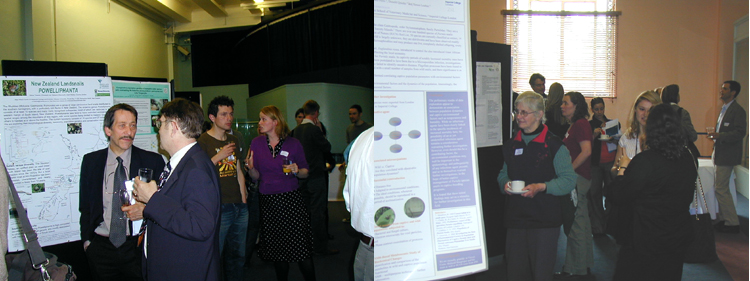

A one-day symposium in the Flett Theatre, Natural History Museum, London
Castelin Magalie, Samadi Sarah, Boisselier Marie-Catherine
The seamounts fauna is highly diversified and most studies underlined its singularity to be endemism. It has been suggested that the spatial distribution of seamounts represents a fragmented habitat which may locally increase speciation rate by breaking up species in small isolated populations. However, recent studies emphasize that this apparent endemism reflects our ignorance of marine biodiversity and its distribution. One consequence of this poor knowledge is that few data are available to understand speciation processes acting on marine organisms and thus to explain the diversity. Moreover, it has been suggested that the allopatric speciation model may not be the rule for many marine organisms and new species can emerge parapatrically. Such models give an important role to habitat heterogeneity and ecological factors. Indeed, natural selection that acts in different directions in different micro-habitats is supposed to be the cause of the genetic divergence among sub-sets of individuals that will then become separated into different species. Thus, the respective importance of these two modes of speciation in the seas remains to be determined. One of the major limitation for the allopatric model is that the marine environment is continuous and allows dispersal over very large distances. Under this model, the dispersal abilities of the organisms should be a determinant trait to understand speciation process. The phylogeographic survey of seven gastropod species with contrasted reproductive strategies living on seamounts near New Caledonia reveals that both allopatric and parapatric speciation processes may occur in marine systems. Allopatric diversification seems related to dispersal abilities, whereas parapatric speciation is observed independently of the mode of larval development of species and seems to be correlated with the seamounts' bathymetry. [Poster]

Fig. 1 The protoconchs of seven species of gastropod with contrasting larval development. Ranging left to right from less to more dispersive they are: Alcithoe aillaudorum (Volutidae), Chicoreus boucheti (Muricidae), Nassaria nova sp. (Buccinidae), Bursa fijiensis (Bursidae), Bursa quirihorai, Sassia remensa (Rannelidae) and Bursa latitude. Within each species, the degree of genetic differentiation among populations (Fst) is assessed with an analysis of molecular variance (AMOVA; Excoffier et al., 1992). N represents number of specimens analysed. At any spatial scale and for each species, the genetic subdivision among the seamount populations remains interrelated to the reproductive mode of the species.
Diversification on Tropical Rocky Seashores: phylogenetic analysis of the rapanine murex snails
Martine Claremont1,2, Suzanne Williams1 and David Reid1
1Natural History
Museum, Cromwell Rd, London SW7 5BD, UK,
2Department of Biology and NERC Centre for Population Biology, Imperial College at Silwood Park, Ascot BerkshireSL5
7PY, UK
Email: m.cl...@nhm.ac.uk
The Rapaninae are a large subfamily of taxonomically perplexing, carnivorous marine snails. This perplexity arises, in part, from the prevalence of convergence within the rapanines and consequent morphological similarity. Bayesian and parsimony analyses of one mitochondrial and one nuclear gene in 15 species within the rapanines and an additional 20 species from across the Muricidae disprove previous phylogenetic hypotheses based on morphological characters. At least five monophyletic subfamilies are supported with the Muricidae: Rapaninae, Ocenebrinae, Ergalataxinae, Muricinae and Muricopsinae. In contrast to morphological phylogenies, the Ergalataxinae are not contained within the Rapaninae in any trees, nor is there any evidence to support the hypothesized sister relationship between Rapaninae and Ocenebrinae. Relationships within the Rapaninae and Ergalataxinae are also highly divergent from those hypothesized from morphological evidence, and two of the genera (Thais and Morula) are polyphyletic. [Poster]
Speciation of Japanese Mandarina and Euhadra
Angus Davison
Institute of Genetics, The University of Nottingham, Queen's Medical Centre, Nottingham NG7 2UH, UK
Email: Angu...@nottingham.ac.uk
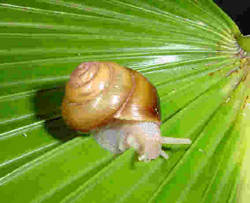 Mandarina suenoae from
Anijima, Ogasawara (Bonin Islands)
Mandarina suenoae from
Anijima, Ogasawara (Bonin Islands)
As part of an ongoing project, I have been studying the genetics and ecology of the genera Mandarina from oceanic Ogasawara (Bonin Islands) and Euhadra from mainland Japan. It has already been established that one or a few individuals of an ancestral Mandarina species colonized Ogasawara between 0.9 and 1.8 million years ago, when the islands rose as a result of tectonic uplift. Speciation on different islands was such that similar ecotypes evolved independently in different lineages and islands. Also, the present-day species take different, genetically-determined ecotypes, depending on their geographic location and local competitors, implying a strong role for ecology in the adaptive radiation and speciation of the genus. In contrast, speciation in Euhadra is less well understood, being much slower, as the genus inhabits an area that is orders of magnitude larger yet has only a few more species (~22 versus ~20), and possibly involves chiral evolution. Here, the respective roles of ecology and chirality in the speciation of these genera will be discussed.
Comparative Study of the Factors Affecting the Population Dynamics of Partula Snails to Aim for a Successful Reintroduction
Ana Rita Gouveia1, Paul Pearce Kelly², Romain Pizzi 3, Donald Quicke 4 and Simon Leather 4
1 Imperial College London, Silwood Park campus, Ascot, Berkshire, UK, SL5 7PY and the Zoological Society of London, a.go...@imperial.ac.uk2 Zoological Society of London, Invertebrate Conservation Unit, Regent's Park, NW1 4RY London3 University of Nottingham School of Veterinary Medicine and Science, 4 Imperial College London4 Imperial College London, Silwood Park campus, Ascot, Berkshire, UK, SL5 7PY
Partula species of Polynesian tree snails are small molluscs, belonging to the class Gastropoda, order Stylommatophora, family Partulidae. They are a unique genus endemic to the Pacific region, and more specifically to The Society Islands. There are over one hundred species of Partula snails described, with 79 species on the International Union for the Conservation of Nature (IUCN) Red List. 50 species are currently classified as extinct, 14 as extinct in the wild, and 15 as critically endangered. Their diet in the wild is largely unknown; they are detritivores and have been observed readily feeding on dead and decaying Hibiscus tiliaceous leaf stalks. They are hermaphrodites and may produce one live, completely shelled offspring, every six to eight weeks.
Wild populations have declined since the introduction of a predatory snail, Euglandina rosea, introduced to control the also introduced Giant African land snail (Lissachatina fulica) which had become an agricultural pest affecting the local economy. The London Zoo coordinates a worldwide captive breeding programme for Partula snails. In captivity periods of notably increased mortality rates have been recorded. While the extinction of Partula turgida in captivity has been postulated to have been due to a Microsporidian infection, investigations of the majority of other captive Partula species population declines have failed to identify causative diseases. Flagellate protozoan have been found to have a high prevalence in many captive Partula snails species compared with a small number of samples from wild snails, and there significance is as yet still uncertain. There are limited data on conditions in the wild, and no work so far performed correlating captive population parameters with environmental factors such as temperature and relative humidity.
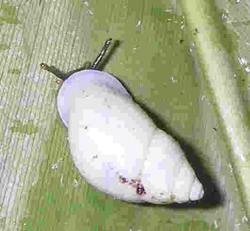
Our previous research indicated that there was a correlation between environmental factors and the dynamics of the population. Interestingly, the different species demonstrated different sensitivity to different environmental factors. [Poster]
Partula hyalina, Tahiti
Molecular taxonomy and speciation among Bathymodiolinae
Lorion Julien & Samadi Sarah
Department of Systematic and Evolution, The Natural History Museum, Paris 43 rue Cuvier 75005,
The biodiversity in deep sea marine environments is still poorly known, slowing down the study of evolutionary processes such as speciation and dispersion. In this context, hydrothermal vents and cold seeps have stirred the attention of biologists. These extreme environmental conditions are inhabited by original communities of endemic organisms. Among the most studied organisms living in those ecosystems are the Bathymodiolinae mussels. Indeed, Bathymodiolinae mussels (Bivalvia: Mytilidae) were thoroughly studied in hydrothermal vents and cold seeps, where it was shown that they have symbiotic relationships with chemosynthetic bacteria. Other species within this subfamily inhabit less known reducing ecosystems such as sunken vegetable material and decaying bones of marine vertebrates. Despite biochemical differences between plant material and bones, both produce dihydrogen sulphides, from lignin or lipids respectively, when decaying on the sea floor. Some species inhabiting sunken woods were yet shown to have chemosynthetic symbionts, among which the thiotrophic bacteria are the most common ones. Our aim is to define a robust taxonomic framework taking into account the diversity of species and their symbionts but also of the substrata, in order to document the evolutionary history of Bathymodiolinae and to determine which factors (such as geographic barriers or symbiotic relationships) drive the speciation in these reducing environments. [Poster]
Dispersal and Speciation in the Big Pond
Chris Meyer
Smithsonian Institution, PO Box 37012, MRC 163, Washington, DC 20013-7012E-mail: Mey...@si.edu
The tropical Indo-West Pacific (IWP) is the world's largest biogeographic province, spanning more than half the globe without interruption. Additionally, and perhaps consequently, the IWP is the world's most diverse marine region. Many species range freely across its entirety with no evidence of restricted gene flow. Given the apparent lack of barriers to larval dispersal, how has diversity been generated in the face of genetic exchange? Previous investigations have shown only weak correlations between dispersal ability, range sizes and diversification rates. However, mounting evidence from combined molecular and morphologic work across a variety of groups, and especially mollusks, is casting new light onto this apparent conundrum. An integrative taxonomic approach is demonstrating that many putatively widespread species are actually species complexes (Cypraeidae, Conidae, Turridae, Acmaeidae, Patellidae, Turbinidae), highlighting the presence of phylogeographic breaks throughout the IWP. Overwhelmingly, dispersal ability is the primary predictor of diversification rates, biogeographic ranges and community assembly. As species ranges fragment under scrutiny, allopatry dominates as the mode for speciation. Additional evidence points to a second driver of diversification, ecological specialization, that allows for more rapid secondary overlap and localized buildup of diversity. The "dispersal conundrum" turns out to be a strawman, drowning in the big pond of the IWP.
Gastropod Endemism in African Fresh Waters: Time, Traits and Topography
Ellinor Michel1 , Jon Todd2, Martin Genner3, Peter B. McIntyre4, Justin Meyer5
1Dept of Zoology The Natural History Museum, London,
UK
2Dept of Palaeontology,
The Natural History Museum, London, UK
3Marine Bio. Assoc.,
Plymouth & Univ. Bristol, UK
4Univ. of Michigan,
Ann Arbor, MI USA
5Michigan State
Univ, Grand Rapids, MI, USA
Tanganyika and Malawi are Africa's oldest and deepest lakes, and hold a range of endemic taxa that have evolved in situ. Our work has shown that although both lakes are home to radiations of endemic gastropods with unusual shell morphologies compared to fluvial relatives, the radiations differ in several significant biological characters. We have used detailed morphological analyses and molecular phylogenetics to explore these contrasts. Malawian and Tanganyikan endemic gastropods were originally thought to be members of the same freshwater family, Thiaridae, however recent work has suggested the Malawian gastropods should be considered thiarids sensu stricto whereas the Tanganyikan gastropods are 'thiarids' sensu lato . The Malawian radiation is currently encompassed in one genus, Melanoides, all of which brood their young and are characterized by parthenogenetic reproduction. Species differences are difficult to delimit based on morphology alone and there appears to be high phylogenetic plasticity in shell character development. Molecular divergence is relatively deep among Melanoides lineages, but much of the diversity is among clones, thus compounding problems with taxon concepts and their delimitation. The Tanganyikan gastropods include 18 monophyletic endemic genera that reproduce by a range of brooding strategies and egg-laying. Shell morphological differences are extreme among the genera, and convergent with marine families. Several Tanganyikan genera have formed species flocks, in the case of Lavigeria extensively, yet shell characters are frequently reliable indicators of relationship and species membership.
The temptation is strong to assume that species radiations, such as these gastrtopod radiations in an aquatic island systems, are driven by adaptation. Indeed, our field work on ecology of the Lavigeria species flock has shown species differences that are likely to be linked with adaptive processes. However, testing the null prediction at the community assembly level suggests that adaptive explanations might not be necessary. We conducted quantitative surveys to test predictions from niche theory versus neutral theory (e.g. Hubbell 2001) among the malacofauna of the Tanganyikan rocky shoreline. Because of its unique combination of linear, dissected habitats and patchy species distributions occurring with high sympatry, this system is uniquely suited to test predictions from neutral theory. Our results indicate a significant effect of tectonically formed habitat barriers and an importance of scale. Future work includes integrating population and species genetics in the same system.
Reconciling morphological divergence and genetic differentiation: two examples
Mary Morgan-Richards1, Simon Hills1,2, Bruce Marshall3,
James S. Crampton4 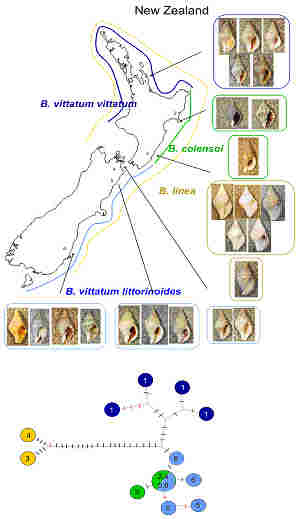
1 AWCMEE, Massey University, Palmerston North, New Zealand; Email: morg...@massey.ac.nz
2 Email: s.f....@massey.ac.nz
3 Te Papa Museum, Wellington, New Zealand; Email: Bru...@tepapa.govt.nz
4 GNS Science, Wellington, New Zealand; Email:
Genetic and morphological differentiation do not always go hand-in-hand and this leads to doubts about the interpretation of biological species from the fossil record. We present data from two marine gastropods where species limits are problematical. 1. The lined whelk, Buccinulum colensoi is common under rocks from low tide to 100m, only on the east coast of North Island, New Zealand. This species is morphologically distinct from the two sub-species of Buccinulum vittatum but genetically it falls within the diversity of the southern sub-species (sequences of ND3 (mtDNA)). 2. In contrast, morphological diversity within the volutes Alcithoe is too small for phylogenetic studies but genetic divergence between species is large (we use 6kb of mtDNA sequence). Thus interpretation of relationships among living and fossil species requires more sophisticated use of shell morphometrics. [Poster
Spatial population structure of common whelk (Buccinum undatum) in Irish waters inferred using genetic and phenotypic methods
Katja T.C.A. Peijnenburg1,2, Alice Antoniacomi1, David Weetman3 and Stefano Mariani1
1 School of Biology and Environmental Science, University
College Dublin, Science Center West, Belfield, Dublin 4, Republic
of Ireland. E-mail: K.T....@uva.nl
2 Institute for Biodiversity and Ecosystem Dynamics,
Faculty of Science, Universiteit van Amsterdam, PO Box 94062, 1090
GB Amsterdam, The Netherlands
3 Liverpool School of Tropical Medicine, Pembroke Place,
Liverpool L3 5QA, United Kingdom
;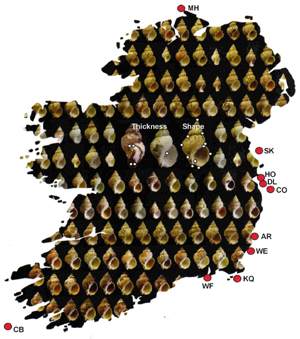
A description of the patterns of spatial population structure in marine species is often best obtained when more than a single method is applied. Genetic methods often fail to detect any significant patterns of differentiation at fine spatial scales, whereas phenotypic techniques can potentially yield a misleading picture as a result of the strong influence of the environment on morphological variation. Selected Irish populations of the commercially exploited marine gastropod Buccinum undatum were studied using both genetic (microsatellites) and phenotypic (shell geometric morphometrics) descriptors. Whelk shell shape exhibited significant variation around Ireland, and its "patchy" spatial pattern is consistent with the existence of local ecological selection. Genetic data indicated a high degree of population differentiation and isolation-by-distance, suggesting demographically independent stocks even within the Irish Sea. [Poster]
Map of Ireland showing sampling locations and morphological spectrum of Irish Whelk, Buccinum undatum. Positions of the shell that were measured for thickness and eleven landmarks that wsere used in a geometric morphometric analysis of shell shape are indicated.
Ecological Speciation of Littorina saxatilis in Galicia
Emilio Rolán-Alvarez
Departamento de Bioquímica, Genética e Inmunología, Facultad de Biología, Universidad de Vigo, 36310 Spain
Email: rol...@uvigo.es
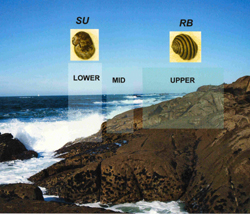 On
exposed rocky shores in northwestern Spain there is a striking polymorphism
in the marine snail Littorina saxatilis that has been claimed
as an example of a putative sympatric ecological speciation process.
Two ecotypes of this species are adapted to different shore levels
and habitats, although they meet and hybridize on the mid shore where
their two habitats overlap. As a by-product of adaptation these ecotypes
have evolved an incomplete premating reproductive isolation where
they meet on the mid shore. Although they are not yet true species,
and the final outcome of the process cannot be predicted, the ecological
mechanisms responsible for this polymorphism could cause sympatric
speciation in similar situations. This model system seems promising
for understanding the molecular and physiological processes occurring
during adaptation.
On
exposed rocky shores in northwestern Spain there is a striking polymorphism
in the marine snail Littorina saxatilis that has been claimed
as an example of a putative sympatric ecological speciation process.
Two ecotypes of this species are adapted to different shore levels
and habitats, although they meet and hybridize on the mid shore where
their two habitats overlap. As a by-product of adaptation these ecotypes
have evolved an incomplete premating reproductive isolation where
they meet on the mid shore. Although they are not yet true species,
and the final outcome of the process cannot be predicted, the ecological
mechanisms responsible for this polymorphism could cause sympatric
speciation in similar situations. This model system seems promising
for understanding the molecular and physiological processes occurring
during adaptation.
Vertical
distribution of the RB and SU Littorina saxatilis
marine
snail ecotypes from Galicia (NW Spain)
Evolution on a Block of Rock; Snail Speciation on Tropical Limestone Karst.
Menno Schilthuizen
National Museum of Natural History 'Naturalis', Leiden, the Netherlands; and Institute for Tropical Biology and Conservation, Universiti Malaysia Sabah, Kota Kinabalu
E-mail: schi...@naturalis.nl
Certain groups of terrestrial gastropods in the Asian tropics have such high calcium requirements that they are obligate dwellers of limestone habitats. In many parts of Southeast Asia, limestone outcrops are scattered like small islands in a sea of non-calcareous soils. This situation has resulted in curious patterns of speciation, which involve extreme short-range endemism, extreme conchological diversity and exuberance, and, consequently, extreme current rates of extinction. I will highlight three case-studies of Malaysian limestone-dwelling microsnails: parapatric cave speciation in hydrocenids, metapopulations in vertiginids, and micro-allopatric speciation in diplommatinids. Together, these studies show the unexpected effects that this naturally fragmented limestone habitat has on adaptive speciation, biogeography, and conservation.
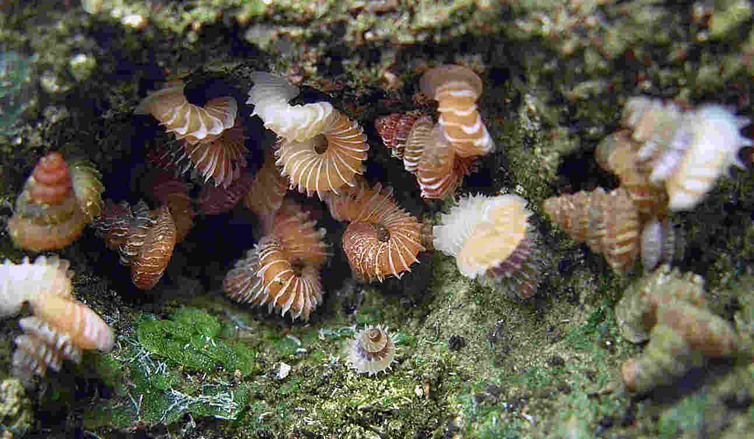
Opisthosoma obliquedentatum at Batu Sanaron, Malaysian Borneo.© M Schilthuezen.
Barcoding Biomphalaria populations around Lake Victoria
C.J. Standley1;2, R.A. Kane1 and J.R. Stothard1
1Division of Biomedical Parasitology, Department of Zoology, Natural History Museum, London, SW7 5BD, United Kindgom. EMAIL: c.st...@nhm.ac.uk; r.k...@nhm.ac.uk; r.st...@nhm.ac.uk2Wade Lab, Institute of Genetics, School of Biology, Queens Medical Centre, Clifton Boulevard, Nottingham NG7 2UH, United Kingdom
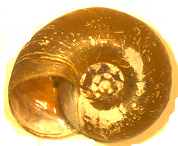 Biomphalaria snails are small, freshwater pulmonates that are widely distributed
throughout the tropics in both Africa and the Americas. They are of
medical importance, in that they act as the intermediate host of the
human parasite Schistosoma mansoni, which causes intestinal
schistosomiasis. However, ability to transmit the parasite varies
at the species level, and even differentiation between populations
is likely to play a role in susceptibility at local scales. The Lake
Victoria shoreline of Uganda is a hotspot for schistosomiasis, but
risk of transmission appears heterogeneous. We hypothesise that this
may be caused by the non-even distribution of suitable snail hosts;
in this study, we sampled over 50 sites along the shoreline for Biomphalaria,
and have combined morphological and molecular techniques to identify
species and populations. We also sought to collect water chemistry
data to gain information about snail habitat suitability. Combining
the snail population data with these abiotic variables may also elucidate
questions regarding the biogeography of the genus within the Lake,
as well as compared to other populations in Uganda, in terms of patterns
of current flow, migration and ecophenotypic plasticity within the
bounds of environmental variables. This poster presents the preliminary
results of this investigation, with a view to continue with this work
more extensively in Uganda, as well as Tanzania and Kenya.[Poster]
Biomphalaria snails are small, freshwater pulmonates that are widely distributed
throughout the tropics in both Africa and the Americas. They are of
medical importance, in that they act as the intermediate host of the
human parasite Schistosoma mansoni, which causes intestinal
schistosomiasis. However, ability to transmit the parasite varies
at the species level, and even differentiation between populations
is likely to play a role in susceptibility at local scales. The Lake
Victoria shoreline of Uganda is a hotspot for schistosomiasis, but
risk of transmission appears heterogeneous. We hypothesise that this
may be caused by the non-even distribution of suitable snail hosts;
in this study, we sampled over 50 sites along the shoreline for Biomphalaria,
and have combined morphological and molecular techniques to identify
species and populations. We also sought to collect water chemistry
data to gain information about snail habitat suitability. Combining
the snail population data with these abiotic variables may also elucidate
questions regarding the biogeography of the genus within the Lake,
as well as compared to other populations in Uganda, in terms of patterns
of current flow, migration and ecophenotypic plasticity within the
bounds of environmental variables. This poster presents the preliminary
results of this investigation, with a view to continue with this work
more extensively in Uganda, as well as Tanzania and Kenya.[Poster]
Patterns from the Fourth Dimension of a Marine Snail Radiation
Jon Todd
Dept of Palaeontology, The Natural History Museum, Cromwell Rd, London SW7 5BD E-mail: j.t...@nhm.ac.uk
Studies of dynamics of diversification of radiating clades are typically derived from the structure of molecular phylogenetic trees together with some added fossil calibration points. As a result our uncovering and understanding of patterns are heavily biased towards the thin time slice of the Recent and its sampled twigs. However, with many molluscs we have the potential to identify fossil biospecies. Despite the good molluscan fossil record, to date there have been few integrated molecular and morphological studies of diversification patterns and inferred modes of speciation. One potential model system is the species-rich marine gastropod Polystira, a genus with numerous fossil and recent species that have radiated extensively in the neotropics over the past 30 myr. From my continuing studies, I will examine the importance of the fourth dimension in unveiling:
i) direct knowledge of species diversity
ii) species durations as preserved in the fossil record
iii) the "increasing cone of diversity"
iv) biogeographic patterns through time.
New Zealand Landsnails: Powelliphanta
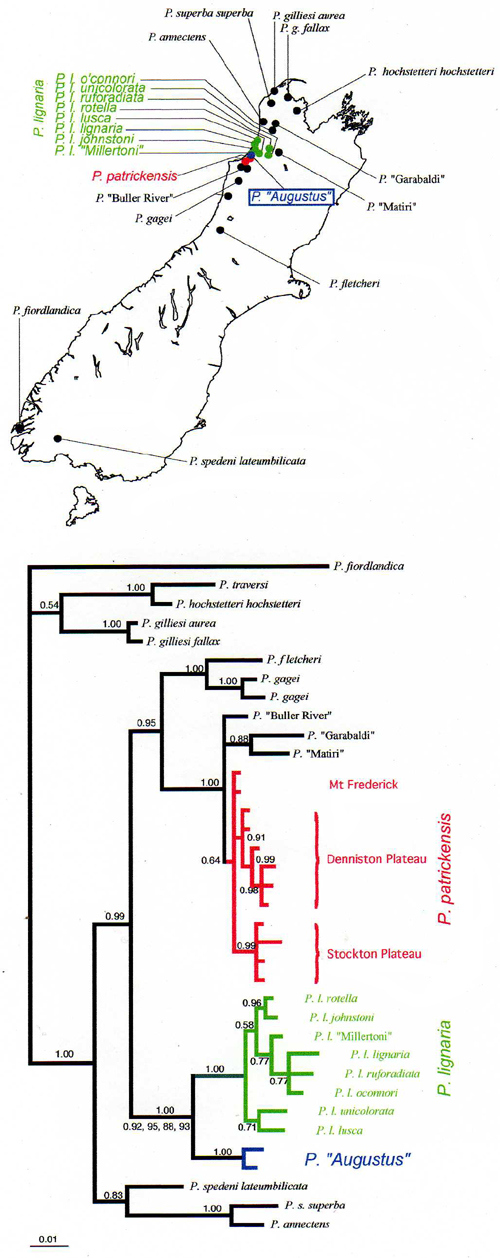
Steve Trewick1, Elizabeth van Melsem-Wenmoth1, Kath Walker2, Corina Jordan1.
1 Allan Wilson Centre for Molecular Ecology and Evolution, Massey University, Private Bag 11-222, Palmerston North, New Zealand. S.Tr...@massey.ac.nz
2 Department of Conservation, Nelson Marlborough Conservancy, Private Bag 5, Nelson, New Zealand.
Rhytidae (Mollusca; Gastropoda; Pulmonata) are a group of large carnivorous, southern hemisphere land snails, with a rich fauna in New Zealand. The endemic genus Powelliphanta consists of at least 10 species and many more recognised subspecies, most of which are restricted to the western margin of South Island, New Zealand. We are exploring their morphological diversity, taxonomy, population genetics, conservation status and molecular phylogenetics. This rich fauna comprises both allopatric and sympatric species, with well-developed phylogeographic structure within many species. This is consistent with subspecific status of many populations. New Zealand's North island appears to have been colonised by Powelliphanta rather recently from the area of most diversity in South Island. This is consistent with the geological youth of southern North Island, but surprising given connection of the two main islands did not occur until the late Pleistocene. Diversification in South Island is complex and by implication, older, and we are currently exploring the evolutionary history of these taxa. In particular, northern South Island is occupied by many species, including morphologically distinct and spatially isolated subspecies. In part of this area, coal extraction is an important source of income with a direct impact on local biodiversity. We have recently examined the status of a population of snails that occupy part of a heavily mined plateau. Our data indicate that the snails at this site (Mount Augustus) are a distinctive evolutionary lineage, more closely related to a nearby lowland species P. lignaria than the spatial and ecological neighbour that also occupies habitat on coal measures P. patrickensis. Powelliphanta "Augustus" appears to be a specialised local endemic species. Despite a growing international awareness of the importance of biodiversity conservation, the demand for foreign earnings continues to take priority over the protection of our biota. [Poster]
Trewick SA, Walker kK, Jordan CJ. 2008. Taxonomic and conservation status of a newly discovered giant landsnail from Mount Augustus, New Zealand. Conservation Genetics (online first).
Schistosoma mansoni disrupts cell defence signalling in schistosome-susceptible Biomphalaria glabrata
Zahida Zahoor1,2 Angela J. Davies1, Ruth S. Kirk1, David Rollinson2 and Anthony J. Walker1.
1 School of Life Sciences, Kingston University, Penrhyn Road, Kingston upon Thames, Surrey, KT1 2EE, UK.
2 Wolfson Wellcome Biomedical Laboratories, The Natural History Museum, Cromwell Road, London, SW7 5BD, UK.
Email: z.za...@kingston.ac.uk, j.da...@kingston.ac.uk, r.k...@kingston.ac.uk, d.ro...@nhm.ac.uk
and T.Wa...@KINGSTON.AC.UK.
Biomphalaria glabrata is an intermediate host for the human blood fluke Schistosoma mansoni. To survive, S. mansoni must suppress the snails' defence responses; the molecular mechanisms by which this is achieved remains largely unknown. We are currently using two laboratory strains of B. glabrata; a susceptible (BB02) and a resistant (BS90) strain to study snail-schistosome interactions. We report here that excretory-secretory products (ESPs) produced during the transformation from S. mansoni miracidia to mother sporocyst interferes with the snails' defence responses. Specifically these ESPs were found to modulate the phosphorylation (activation) of extracellular signal-regulated kinase (ERK) in schistosome-susceptible defence cells. In contrast, ERK signalling in haemocytes from B. glabrata resistant to schistosome infection was found to be unaffected by ESPs. The ERK pathway plays a vital role in coordinating molluscan defence reactions including phagocytosis and encapsulation (Zelck U. E. et al., 2007) as well as regulating the production of cytotoxic molecules (Hahn U. K. et al., 2000; Wright B. et al., 2006). Our finding that S. mansoni ESPs can disrupt ERK signalling in susceptible haemocytes implies that the parasite may be using this strategy to evade detection or blunt host immune responses. [Poster]
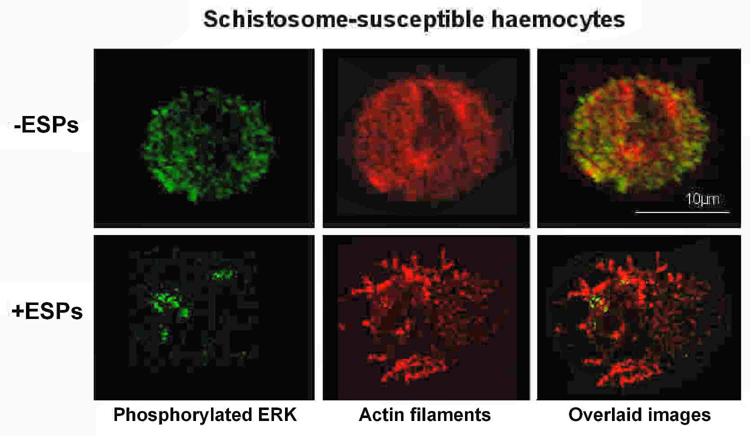
Biomphalaria glabrata haemocytes imaged using confocal microscopy showing down-regulation of ERK following Schistosoma mansoni ESP challenge.

Speciation in Molluscs meeting. The poster display in the foyer of the Flett Theatre at the Natural History Museum. Left, Suzanne Williams, organiser of the meeting, with Richard Cook, The Society's Membership Secretary. Right, Society Secretary Jackie Trigwell and President Georges Dussart seem to be listening to a fisherman's tale from former Bulletin Editor, June Chatfield.
